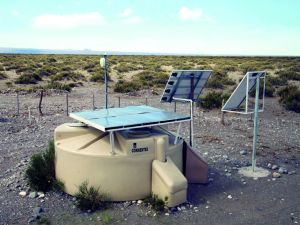The Pierre Auger Observatory in Argentina, an international large-scale experiment to study cosmic rays, will be continued until 2025 and extended to “AugerPrime”. The observatory, for the project management of which Karlsruhe Institute of Technology (KIT) is responsible, will be upgraded with new scintillation detectors for a more detailed measurement of gigantic air showers. This is required to identify cosmic objects that accelerate atomic particles up to highest energies.
In mid-November, scientists of the observatory and representatives of the funding partners met at Malargüe/Argentina for a scientific symposium on AugerPrime. During a ceremony with many international representatives of science and politics, including the Argentinian Minister of Science Lino Barañao, an agreement on further operation of the observatory until 2025 was signed. KIT was represented by Professor Johannes Blümer, Head of the Physics and Mathematics Division and member of the Auger Supervisory Body. He led the guests through the program, in the course of which all speakers referred to the very fruitful international relations. “This is a good day for science, for peaceful cooperation of countries, and for our young talents in this dynamic and inspiring environment,” Professor Johannes Blümer says.
The Pierre Auger Observatory in the province of Mendoza/Argentina is the world’s biggest and best known project for studying high-energy cosmic rays. Since 1998, more than 500 scientists from 16 countries have been cooperating under this project. The largest group comes from KIT that is responsible for managing the project. To elucidate the origin of the rays coming from the depth of the universe, the Pierre Auger Observatory covering an area of 3,000 square kilometers in the Argentinian pampas observes the air showers produced by atomic nuclei colliding with the earth’s atmosphere. A surface detector consisting of 1660 tanks filled with highly pure water, in which the high-energy particles generate flashes of light, and a fluorescence detector of 27 telescopes observing fluorescent light in the atmosphere record the millions of secondary particles and radiation emissions generated by cosmic particles in the atmosphere. Observations of such air showers are used to infer properties of primary particles, such as energy, direction, and mass.
Results obtained so far have brought new fundamental insights into the nature of highest-energy cosmic rays. In particular it was found that cosmic-ray flux decreases considerably at the highest energies and that maximum energy of cosmic rays can now be inferred experimentally. At the highest energies, several thousand times above what can be achieved at CERN’s accelerator, “the data imply that this flux suppression marks the limiting energy of cosmic accelerators,” Dr. Ralph Engel, leader of the Pierre Auger Group at KIT’s Institute of Nuclear Physics (IKP) explains. Nevertheless, an even more detailed measurement of individual air showers is required to solve the puzzle of the origin of the most energetic particles in the universe. Only by extending the observatory to AugerPrime can the cosmic objects be identified, which are violent enough to accelerate atomic particles to such tremendous energies.
The AugerPrime upgrade to the Observatory enhances the 1,660 existing water-Cherenkov detectors with a large-area of plastic scintillator. This scintillator is excited by a passing-through high-energy particle. Excitation energy is released in the form of light. By combining information from both detector types, the different components of the air shower can be distinguished efficiently and the mass of individual primary particles can be determined with a high precision. Together with an update of the readout electronics and some other measures, this will enhance the overall performance of the observatory in measuring gigantic air showers.
Being “The University in the Helmholtz Association”, KIT creates and imparts knowledge for the society and the environment. It is the objective to make significant contributions to the global challenges in the fields of energy, mobility, and information. For this, about 10,000 employees cooperate in a broad range of disciplines in natural sciences, engineering sciences, economics, and the humanities and social sciences. KIT prepares its 22,800 students for responsible tasks in society, industry, and science by offering research-based study programs. Innovation efforts at KIT build a bridge between important scientific findings and their application for the benefit of society, economic prosperity, and the preservation of our natural basis of life. KIT is one of the German universities of excellence.

